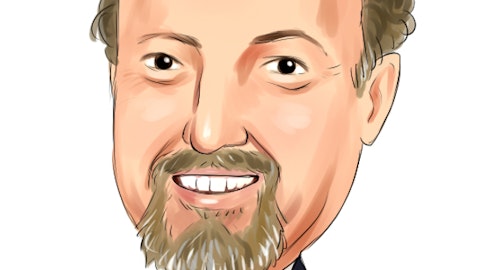Rick Wise: Okay, great. And let me turn to some of the new and incremental features you talked about, Gary. I’m sure all of us on the call have been talking to doctors. I’ve been hearing a variety of additional features. Some sound quite compelling. Can you give us any flavor? I mean, first, I’d be happy to hear from you what some of them could be? But how quickly, given what you know today, when could we see those features that, again, I would assume would enhance the value? Are we going to see them this year, second-half, or is it more likely that’s something for next year as you get supply chain where you want it to be? Thank you.
Gary Guthart: Yes, I think as we add capabilities and time, we have some imaging things that we want to do. We have some things in terms of software upgrades and analytics power and some things we want to do in terms of integration. That’s much more likely to be ‘25 and later than ‘24. A lot of ‘24 will be making sure that we and our suppliers feel great about what we’ve got and then adapting to any immediate feedback that we see.
Operator: And we will go to the next line. Adam Maeder, Piper Sandler. Please go ahead.
Adam Maeder: Good afternoon. Thank you for taking the questions, and congrats on the nice quarter. I wanted to start by asking about the force feedback instruments. I was hoping, Gary, you could share a little bit more color on the feedback that you’re getting from clinicians thus far into launch? And then if I understand correctly, you have six force feedback instruments that are used across different common procedures. Will you look to expand the portfolio of that technology going forward? And if so, what might that look like? And then I had a follow-up, thank you.
Gary Guthart: Sure, we’re getting a variety of feedback on the instruments themselves. Just a reminder for everyone, they have very sensitive sensors that are built into the distal end, in the body end of the instruments that are sterilizable and cleanable, and they report back contact forces with tissue which at a sensitive way, which has been a goal for us and for surgery for a long time. So it’s a hard technology, we’ve been really excited to bring it to market. We will hear everything from, hey, I’m getting great results with da Vinci X and Xi today, that has very limited version of haptics. It really doesn’t have in-body sensing. It does have a little something, but it’s not sensing in the technical sense. And that’s true, they’re getting great results.
So it’s a new sense. That said, people are quite interested to explore where it will take them. And what’s interesting is that when you’re using a force sensing instrument, it’s sensing whether you turn on force reflection into the surgeon’s hands or not. So the surgeon can feel it, they can turn it on, or they can turn it off, but still measure so that they have the feeling experience of an X or an Xi. And what they find when they turn it on and off is that the amount of force that they apply during surgery to tissue decreases when force reflection into the hands is on. And so the big question is what’s the clinical value of that? What will be the implications for patient outcomes by procedure and by technique? And that’s what they’re going to go explore and we will help them do that exploration.
So now we’re talking about the future, what could happen. I suspect, I believe, this is a personal opinion. There will be types of procedures and types of patients where having lower force applied to tissue during the surgery is going to be clinically meaningful. And we have to go prove that. So I think it’s quite interesting. The technology is sophisticated. We are with our manufacturing partners learning how to make these at scale with good yield and robust. It’s a worthy endeavor, but it is not easy and we’re going to focus on it, make sure that we get what we want. We want to make sure we have robust and high yield products, we want to extend their lives to help the economics of our customers and our economics. So that is our first focus.
As to the six instruments, I’m going look to Jamie as to whether the sixth number is right, I think it is. Certainly over time, we have the opportunity to extend it to other instruments. But that first set of six are the ones that we thought were right. Six is the right number, Jamie?
Jamie Samath: It is, and it’s a combination of graspers and needle drivers, and those instruments are used in very common tasks, dissection, retraction and suturing.
Adam Maeder: Thanks Adam.
Operator: Alright, we’ll go to the next line Drew Ranieri, Morgan Stanley. Please go ahead.
Drew Ranieri: Thank you taking the questions, maybe just on SP for a moment with the indication expansion in Europe. Can you talk about that a bit more, Gary? And I was hearing from a surgeon today that the CRSA Conference in November in Rome could be pretty important for just getting broader adoption from European surgeons, but does that inform how you could approach the U.S. market with a broader indication? And then I just had a follow-up.
Gary Guthart: Yes, yes, I’m actually here in Europe, have been for the last couple of weeks talking to SP surgeons here, I think the early uptake and early excitement is quite palpable. Where we’ve had broad indications, as you know, in Korea and now Japan, we’ve seen a nice uptake in adoption and good study, good clinical study. And I think that the surgeons here are building on that. They’re learning from and adapting what they see in the rest of the world and getting excited about it. So I’m encouraged. How deep that goes? It’s still early days here in Europe, we will see. But we’re starting to see fairly long case studies in things like colorectal surgery coming out of Asia and other places. We have submitted, as Jamie had mentioned, for an additional indication in the United States, we have another one coming.





